| |
"A man is not a human being without mercy. Even if you are hard on yourself, be merciful to others." |
| |
Benevolent governor Masauji's advice to his son |
It's sometimes the case that you know you're watching a great film even before the first ten minutes are up. I'm not talking about the sort of opening firework display employed by Hollywood to hook the impatient, but films that exert an instant hold through the intrigue of their story and the manner of its telling. Sanshō dayū is just such a film.
The setting is late Heian period (10th century) Japan, a time when the wealth and power of the ruling classes was built on the back of slavery, and private estates were effectively immune from local government interference and decree. Mind you, given the level of bribery and corruption suggested here, it's not hard to see how that status quo was maintained. The exception to the rule is Masauji, governor of Mutsu, whose concern for the welfare of the poor has endeared him to the local populace but angered those in power, who order that he be removed from his post and transported to the distant province of Tsukushi. For their own protection, he sends his wife Tamaki, their young son Zushio, and their baby daughter Anju to stay with Tamaki's brother in Iwashiro until the heat dies down. Six years later, Tamaki has received no news of her husband, so decides to make the long and difficult journey to Tsukushi with her two children and their devoted servant Ubatake, unaware of the perils that lay ahead for them all.
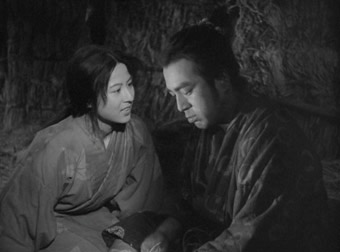
It's inevitable that we approach films with certain expectations for their style and structure based on experience of other works of that era, genre and nationality. Made in 1954 during what was a rich period for Japanese cinema,Sanshō dayū surprises from the off by setting up its story in non-linear fashion, with Tamaki and her party already en route to Tsukushi, with their back-story revealed though flashbacks that are intercut with the narrative present, the temporal shifts identified only by a change of locale and the character names. There's nothing flashy in this approach, no cinematic showing off on the director's part, just inspired and economic storytelling. And that, surely, is a particularly strong foundation for great cinema.
Sanshō dayū is one of only a handful of films made by director Mizoguchi Kenji – who made over eighty – that have been seen in the UK in recent years beyond the specialist circuit, and yet he is widely regarded as one of the greatest of all Japanese filmmakers. It's hardly surprising when the available evidence includes works as extraordinary as Saikaku ichidai onna [The Life of Oharu] (1952), Ugetsu monogatari [Tales of Ugetsu] (1953) and Sanshō dayū (alternatively known in the West as Sansho the Baliff or Sansho the Sheriff), the very film under discussion here.
Sanshō dayū is not a film destined to lift audience spirits and send them out of the cinema with dizzy smiles on their faces, but it never pretends to be. As the opening subtitles (which curiously have no vocal or visual equivalent) assure us, this is a tale full of grief, set in an era "when mankind had not yet awakened as human beings." It's a story driven by misfortune and tragedy with little in the way of emotional reprieve, but like the tragedies of Shakespeare, it compels through the astonishing poetry of its telling. Beautifully lit and framed, there's an increasing sense of foreboding to the early scenes (enhanced by Fumio Hayasaka's unsettling score), as the party is unable to find shelter for the night due to a government ban on offering lodging to strangers, the result of a series of kidnappings of women and children in the area. An old Shinto priestess takes pity on the travellers and offers them food and a place to sleep, but turns out to be working with the very bandits whose activities prompted the government edict that has previously denied them shelter. The boat journey she has arranged for the following morning is used to separate Tamaki from her children, an extraordinary scene that provides a striking demonstration of Mizoguchi's skill at staging emotional drama, his camera placement and editing so ahead of its time that it could comfortably stand alongside any modern-day equivalent (the brief shot in which the children are observed from the departing boat could be straight out of Scorsese).
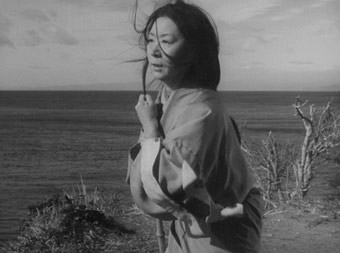
Tamaki is transported to the island of Sado to serve as a courtesan and all but drops out of the film from this point, the focus then narrowing to follow the fate of Zushio and Anju, as they are sold into slavery on the estate of a certain Sanshō dayū. (It's an unusual aspect of the film that its title refers not to the central character but a supporting role, one whose narrative importance stems from the impact he has on the lives of others.) A merciless and unfeeling taskmaster who brands any slave who attempts to escape, his only saving grace is his son Tarō, who despairs at his father's brutality, takes pity on the two children, and promises to help them in years to come, then promptly departs from the estate.
Ten years later, their slavery has had differing effects on Zushio and Anju. Anju has retained her father's benevolence and still dreams of reunification with her mother, while Zushio has become hardened to the feelings of others and acts as a gang boss for Sanshō, unflinchingly branding a 70-year-old would-be escapee, the guiding words of his father that he once found so inspirational seemingly forgotten. Then one day Anju is asked to explain the duties to new slave Kohagi, a girl who was kidnapped from Sado island. Despite Anju's pleading, Kohagi is unable to recall Tamaki, but is soon singing a mournful lament that she learned there, one that cries out for a son and a daughter named Zushio and Anju... It's hard to describe the astonishing emotional kick that this scene delivers – honestly, I was fighting back tears by the end of it, but even this doesn't prepare you for the brief but devastating glimpse of Tamaki's story, her desperate cliff-top rendition of the song as heart-rending a scene as I have watched in years. It would be unfair to elaborate on where the story goes from here, which means I can't discuss an act of self-sacrifice that was championed by writer Robin Wood as one of the most exquisite moments in Japanese cinema, or a final twenty minutes in which a seeming turnaround of fortune that is undercut by an ending that both satiates expectations and kicks your feet from under you, and...well, you'll just have to see it.
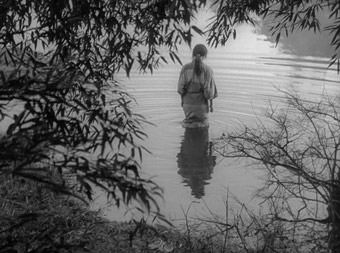
Watching the film for the first time in some years with a Japanese friend, as I often do with older Japanese works in the hope of getting an insight into cultural elements I might otherwise have missed, proved a mixed blessing here. Her fondness for the Mori Ōgai story on which the film was based prompted a series of complaints about alterations made by Mizuguchi and scriptwriters Yoda Yoshikata and Yahiro Fuji. Unfamiliar as I was then with a story whose roots extend back far beyond Ōgai's version, I have to disagree, and having now read the story I firmly believe that these changes enhance the film's exploration of the strength and fragility of idealism and resistance in the face of long term oppression, themes that inevitably invite a religious as well as political reading.
Sanshō dayū is a tragic but beautifully told story of humanity and the bonds of family, one whose technical perfection (few if any directors are able to make such emotive use of wide shots as Mizoguchi) is matched by its remarkable dramatic and emotional power. It's a work that fully justifies its extraordinary reputation, and one that will tear your heart in two.
Given the justifiably high esteem in which Sanshō dayū is held worldwide, there's a temptation to see Gion bayashi as the supporting feature of this two-film set. But while it may not have achieved the later film's classic status, if you're collecting evidence to support Mizoguchi's reputation as a giant of Japanese cinema, then Gion bayashi is still a compelling persuader.
The title translates as Gion Festival Music, Gion being a district of Kyōtō famous for its tea houses and geishas and if you're wondering what the relationship is between those two Japanese cultural icons then a quick bit of research might be in order. It's not a bad idea anyway, as Gion bayashi assumes a degree of understanding of the world of the geisha, inevitable in a film made for a home market where such knowledge is common. For the aware foreign viewer it offers and intriguing window into a culturally unique profession and lifestyle. Whether its technical accuracy has been subject to dramatic licence is another matter, and probably beside the point.
The initial focus of the film's attention is Eiko, the 16–year-old daughter of former geisha Ochiyo, whose recent passing has left her daughter in the care of an uncle who expects her to pay off her mother's funeral expenses by sleeping with him. Eiko approaches her mother's former colleague Miyoharu and begs to be taken on as a trainee geisha, and despite the refusal of Eiko's father Sawamoto to act as a guarantor, Miyoharu agrees, borrowing the required funds from the matriarchal Okimi, a Gion tea house owner of fearsome repute and influence.
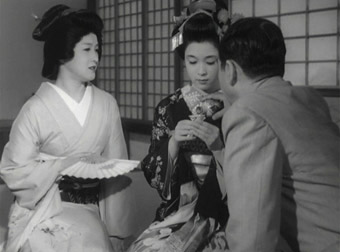
There's an inevitable fascination in the detail of Eiko's training, as she learns to dance, perform the tea ceremony, and play the shamisen, though my Japanese friend took issue with the suggestion that this training would also involve scrubbing floors, given the importance of smooth skin and hands to a geisha's image. Particularly memorable is the elderly instructor who reminds the girls in her charge that those visiting Japan see geishas as representative of the country's beauty, and that the most beautiful and emblematic geishas of all are those of Gion. "Like the tea ceremony and Noh theatre," she tells them, "we are living works of art," intriguingly suggesting that they may also be called, "intangible cultural assets."
A year later, Eiko's training has progressed well enough for her to be given the geisha name of Miyoei and be prepared for her presentation to the district. This is a scene of particular fascination to non-Japanese viewers, as Eiko is dressed and made up in a manner as elaborate as any kabuki theatre performer and taken on a tour of the district by Miyoharu, her hayoka-san (an older male employed to assist with the more physically demanding aspects of a geisha's costume), and his assistant, where she is presented at each of the local tea houses and restaurants and warmly greeted by everyone she meets. In the West there is no equivalent to this ritual because there is also no non-Japanese equivalent of the geisha, a woman rigorously trained in dance, music and cultural rituals who is a symbol of cultural beauty and the subject of widespread respect, but whose duties may also extend to sleeping with her customers.
Following Eiko's presentation, she and Miyoharu are introduced by Okimi to the lively Kusada and the younger executive Kanzaki, whose business favour Kusada is attempting to court. As Kusada takes a shine to Eiko, Kanzaki becomes captivated by the older Miyoharu, feelings that are reciprocated by neither woman. It's the sometimes fractious and layered relationships between the geishas and these two businessmen that give the film its narrative and dramatic meat, and nothing is quite as simple as it initially seems. Miyoharu refers to Okimi as 'mother', for instance, a term that is likely more one of respect for her authority in the district rather than an acknowledgement of a biological connection. Nonetheless a mother-daughter relationship clearly exists between them, with Miyoharu expected to conform to Okimi's wishes and punished when she does not, with her refusal to sleep with Kanzaki resulting in a string of instant appointment cancellations at Okimi's orders.
Eiko's bond to Kusada is more complex but equally subject to financial powerplay. Both she and Miyoharu are reticent to accept Kusada as Eiko's sponsor, but it turns out that he already has a foot in this door, having provided the money to Okimi that was borrowed by Miyoharu for Eiko's training and clothing. Even the relationship between the two businessmen is more delicate than it first appears, a friendly chat about a possible deal masking both its life-or-death importance to Kusada's company and the careful plans he has made to secure it. The most intriguing relationship of all is the one that develops between Miyoharu and Eiko. Initially a business investment, Eiko comes to symbolise to Miyoharu her own lost youth and innocence, about which she becomes increasingly protective, reflected in her clear apprehension and agitation at the prospect of Eiko actually sleeping with a client.
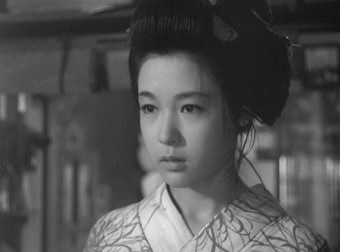
Gion bayashi develops into a story of power and exploitation whose observations extend beyond the cultural and the profession at its centre. Eiko's rebellious questioning of geisha traditions and subservience – she bemuses an elderly instructor with her suggestion that a geisha would have the right to take legal action against any man who makes forceful advances – proves ultimately ineffective in a system in which women may have iconic status but are ultimately powerless. A reminder of what could lie in store were it not for the protection offered by their income is provided by Eiko's father, whose failed business and faltering health eventually leads him back to Miyoharu as a beggar rather than the customer he once was, the prospect of suicide more preferable to him than destitution.
It may not have Sanshō dayū's almost epic sense of tragedy, but Gion bayashi is still a moving and compellingly told story, and is never as downbeat as the above analysis might suggest, the brief scenes in which geishas are shown partying with customers being infused with an infectious exuberance that suggests there is definitely a positive side to the geisha's world. Dramatically, the film exerts an unwavering hold, Mizoguchi's typically effective use of wide shots and locked-on-character dolly shots connecting us directly to the fate of the two leads, and there's even a touch of Ozu in framing and character placement in some sequences. The performances of even the supporting characters strike a neat balance between melodrama and naturalism, particularly evident in Kawazu Seizaburō's turn as Kusada and his instantaneous switch from pleasure to business when outlining to Miyoharu the true reason for their Tōkyō trip, or in Shindō Eitarō's presentation of Suwamoto as a sad but pitiable figure, resigned and world-weary rather self-indulgently depressed.
Gion bayashi is certainly seen by some as a minor Mizoguchi work and maybe that's true, at least when stood against his finest achievements. But lesser Mizoguchi still outclasses most of the competition, and it's indicative of the regard in which I hold the film that I'd be recommending it even without the presence of it's exalted companion. I have to say that my Japanese friend was not so taken with it, something she put down to over-familiarity with the setting and story elements. But I've watched it three times now and if anything my appreciation of its virtues, of which there are many, has increased with each viewing.
Both films are framed in their original ratio of 1.37:1 and have clearly undergone digital restoration, although Sanshō dayū has fared better here than Gion bayashi. Detail and contrast on Sanshō dayū are very good and the print is almost dust free, and although there are still traces of film damage, they have generally been pushed back, so to speak, and are for the most part unobtrusive. There is grain in evidence and the otherwise solid black levels to grey out a little in some of the dimmer interiors, but for the most part the transfer looks first rate, and apparently compares well with the Criterion US release from earlier this year.
The quality of the Gion bayashi transfer is less consistent, with weaker contrast in many scenes, more obviously visible repair work and uneven black levels – daytime exteriors are generally impressive, while darker interiors are weaker. Apart from the dirt-damaged opening credits, the print is very clean.
Both films feature Dolby 2.0 mono tracks, which are true to the original film prints. The slight background fluff onS anshō dayū is what you'd expect even for a restored film of this age, but it clear enough otherwise. Gion bayashi's soundtrack has noticeably more crackle and a slight distortion on loud noises such as musical instruments, but again does rather well for its age.
Tony Rayns on Mizoguchi, Sanshō dayū and Gion Bayashi (10:11 and 28:02)
A consistently interesting look at Mizoguchi's life and career, with emphasis on his work on the two films in this set. Save for a few cut-aways to photos or posters, this is a one-shot address to camera, but Rayns is possibly this country's foremost expert on Japanese cinema and is a fountain of fascinating information about the films and their director, and unless you're very well read on Mizoguchi there should be a fair amount that is new here.
Original trailer for Gion Bayashi (3:25)
Plastered with dirt and damage, but this is hardly surprising – I'm amazed the trailer even exists this long after the event. The contrast and detail are still very good.
Teaser trailer for Gion Byashi (2:09)
As above in terms of picture quality, the teaser is of particular interest because it includes some (staged) behind-the-scenes footage.
Booklet
The usual Masters of Cinema booklet is another one to treasure, with full credits for both movies (more comprehensive than you'll find anywhere on the internet), a 1973 Film Comment article on Mizoguchi by Robin Wood, a 2005 essay by Mark Le Fanu on Sanshō dayū comparing the film to the Mori Ôgai's story, a 2005 essay by Le Fanu on Gion bayashi, and an extract from a 1937 Kinema Junpo interview with Mizoguchi on his attitudes towards geishas, all of which make for excellent reading. Best of all, there's a translation of Mori Ôgai's 1915 story on which Sanshō dayū was based, allowing us to make our own direct comparisons.
Either of these films would come recommended on their own merits, but having both in one set is a rare treat for fans of Japanese cinema and classic cinema in general. The first of four proposed 2-film sets of Mizuguchi's later work from Masters of Cinema, this is the perfect Christmas gift for the discerning film fan, especially one yet to experience the compelling beauty of the cinema of Mizoguchi Kenji. Highly recommended.
The Japanese convention of surname first
has been used for all Japanese names. |